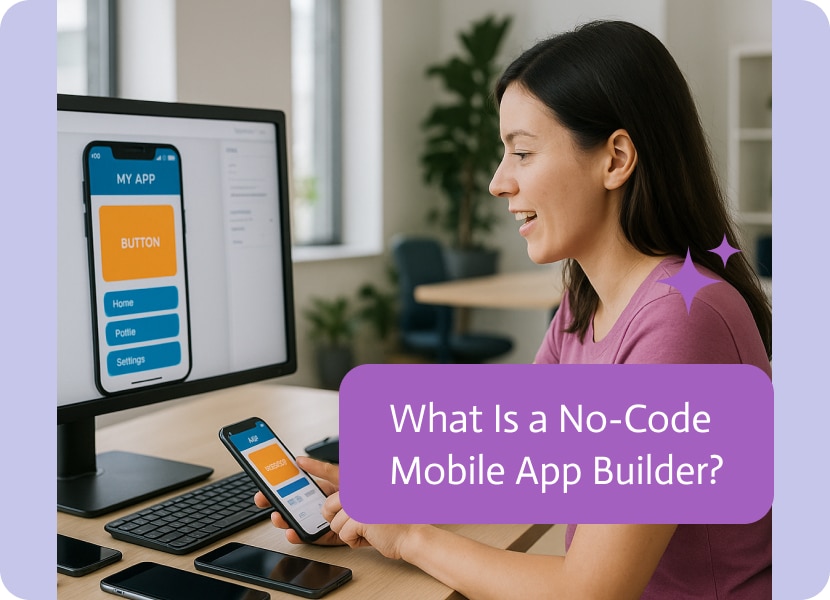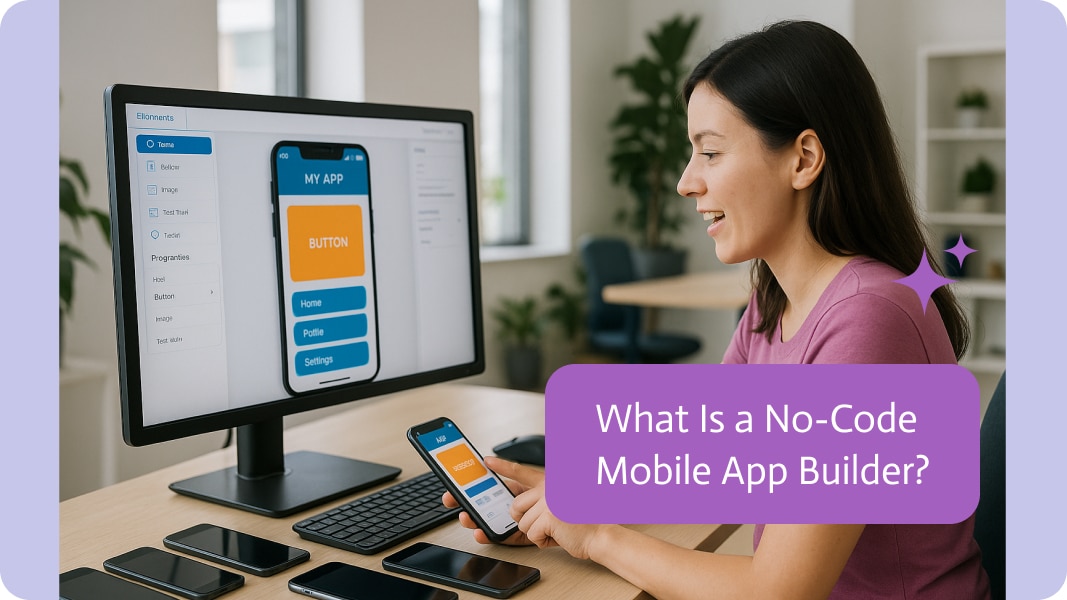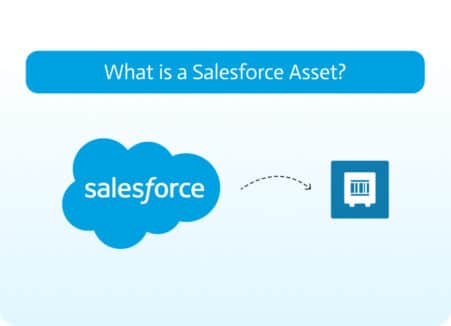

What Is a No-Code Mobile App Builder?
A no-code mobile app builder is a platform that uses software which allows you to design and launch mobile apps without writing any code. Instead of hiring developers or learning super in-depth programming languages, you simply use an interface to drag, drop, and customize various app elements that make the whole thing work, such as buttons, forms, screens, and workflows.
Anyone from entrepreneurs to small business owners now have the chance to create fully functional apps for iOS and Android without being an expert. And in 2025, the no-code revolution is only accelerating.
How No-Code App Builders Work
No-code platforms massively simplify the entire app-building process. Here’s how:
1. Template or from Scratch
Most no-code builders offer industry-specific templates, e.g., for food delivery, e-commerce, fitness, or tools. If not, you can always start with a blank slate for full control.
2. Use Drag-and-Drop Tools
Your user interface (UI) can be designed by dragging elements onto each screen:
- Buttons
- Text blocks
- Navigation menus
- Forms
- Videos
- Lists or product cards
You can customize colors and layout styles, amongst a myriad of other aspects to more closely match your brand.
3. Add Functionality and Logic
Determine how your app behaves using visual workflows or rule-based logic. Examples:
- “When a user taps this button, go to the checkout screen.”
- “After login, show the user’s profile data.”
- “If this form is submitted, send data to Google Sheets.”
4. Connecting Data Sources
Many no-code app builders have the ability to integrate with many other external tools, including:
- Airtable
- Google Sheets
- Firebase
- Stripe
- REST APIs
This is how you are able to display dynamic content, collect user input, and even handle secure logins.
5. Preview and Publish
Testing your app on working devices, then publish directly to the App Store, Google Play, or as a Progressive Web App if you prefer. Some platforms will even generate the code for you automatically.
What You Can Build With No-Code Mobile App Builders
In 2025, no-code app builders now pack enough muscle to turn nearly any idea into a working mobile application. Some of the more popular projects people are launching include:
Customer-Facing Mobile Apps: Perfect for orders, bookings, loyalty programs, content delivery, or simply keeping the customers attention.
Startup MVPs: A low-cost way that allows testing your app concept without a full tech team chewing through cash.
Internal Business Tools: Quickly whip up dashboards, inventory trackers, field-data forms, or task boards that keep employees in sync.
E-Commerce and Membership Apps: Sell goods, deliver locked content, or roll out subscription services right from a user’s phone.
Education Platforms: Used in developing training manuals, certification tests, or quiz apps without paying for a full learning management system.
Community & Social Apps: Set up member hubs with profiles, news feeds, and in-app chat which encourages users to keep on talking.
If you can imagine it running on a phone, a no-code builder will probably get it out the door faster and cheaper.
Who Can Benefit From No-Code App Builders?
These platforms exist mainly for folks who aren’t full-time coders but need results yesterday:
- Founders & Entrepreneurs: Launch an MVP or finished app without waiting on developers.
- Small Businesses: Turn booking, loyalty, or ordering systems into handy mobile apps.
- Designers: Quickly turn a Figma prototype into a live, clickable mobile experience.
- Agencies: Ship client projects with less coding time, causing lower burn and higher profit margins.
- Educators & Coaches: Use a No-Code App Builder to Reach Your Audiences.
No-code app makers let anyone with a good idea build a mobile tool right from a laptop or phone.
Reasons to Try a No-Code App Maker?
Platforms such as these don’t just help you skip code; they also boost speed, shave budget, and let creators test bold concepts.
Move Fast: Launch in Days, Not Months
With classic app builds, the clock can drag for half a year or longer. Between wireframes, code, QA tests, and final launch, every tweak adds weeks. No-code tools lift that weight. You set up the screens, lay out rules, and link data in one clear workspace. Because of this, you can:
- You can shape a basic version over a weekend.
- You can run quick A-B tests without chasing a dev team.
- You can jump into the market ahead of rivals still sketching ideas.
Smaller Budget: No Developers, No Hidden Fees
Bringing on even a handful of mobile coders can burn through thousands and then tens of thousands of dollars fast. And those numbers climb every time you need an update, patch a bug, or add a feature.
No-code platforms slice development costs which lets you get building, testing, and making improvements on your own, or with a small squad-using click-and-drag tools that anyone can pick up.
Most sites also offer low-priced monthly plans, and several let you launch simple apps for free for as long as you need.
- Startups that stretch every dollar
- Small shops needing a Branded tool but priced out of hiring an agency
- Hobbyists or freelancers spinning up side hustles or early prototypes
Flexibility: Update on the Fly
With no-code, pivoting is quick. Want to make a slight adjustment to the layout, rewrite one screen, or slide in a new button? Now you can do it instantly. Changes that not so long ago took days or weeks, like deploying fresh builds to stores, for example, often melt away to a handful of clicks.
Many builders even support live updates, allowing:
- Make refinements to the design when user feedback pours in
- Flip seasonal deals on or off with a tap
- Patch bugs without trudging through long resubmit loops
Cross-Platform Output: iOS, Android, and Web
Keeping two codebases for iOS and Android can feel like running in place. You end up hiring two teams, juggling two schedules, and spending twice as much money just to keep up.
No-code tools cut through that mess, and with the vast majority, you start with one design and build:
- Use the visual editor to lay everything out
- Export a native iOS file (.IPA), an Android package (.APK), or a Progressive Web App (PWA)
Some even submit to the App Store for you. That alone saves weeks of work and a big chunk of your budget, letting teams reach a larger audience much faster.
No Technical Barriers: Anyone Can Build
No-code’s main pitch is simple: you do not have to code to be able to launch your very own app.
- Swift if you make iPhone apps
- Kotlin or Java if you stick to Android
- React Native and Flutter for cross-platform builds
- All those DevOps tools for pushing updates
- Backend tricks for databases or even APIs
Every bit of that heavy lifting runs in the background. You concentrate on what the app should do and how it should look; the platform makes sure the engine purrs under the hood.
Non-tech founders can launch lean tech startups, while designers can drag-and-drop mockups into working apps. Marketers can spin up custom campaigns in hours and educators can whip up mobile tools that reach students fast, even internal teams can digitize approvals, reports, and processes overnight. Its code-free approach is real tech democratization, and it is completely changing who gets to build a part of the future.
Downsides
No-code builders deliver big wins, however, that’s not to say there won’t be a few trade-offs.
Complex Custom Features: If an app needs advanced AI, smart hardware links, or industry-specific APIs, no-code may not plug in straight out of the box.
Performance Limitations: Apps stitched together with off-the-shelf blocks sometimes run a beat slower than hand-coded solutions.
Vendor Lock-in: Many platforms do not let you export clean code, which anchors you to their pricing, updates, and hosting forever.
Design Freedom (on Some): Depending which builder you’ve chosen to go with, ultra-custom looks often need tricky workarounds or bits of embedded code.
Even so, for at least 90 percent of community, startup, and small-business use cases, no-code gets the job done beautifully.
Why No-Code Builders Matter in 2025
As every second company races online, no-code tools level the playing field like never before. You no longer need a big development team, months of testing, or taking late night classes trying to learn how to code just to turn a mobile app idea into reality.
Thanks to no-code builders, entrepreneurs, community groups, and small shops everywhere can build custom software without jumping through technical hoops. If you can explain an idea, you can now shape it yourself.
Noca: A Smarter Way to Build No-Code Mobile Apps
For anyone who wants a fresh, AI-driven no-code platform, Noca will prove to be an indispensable tool. Some of the useful twists to the drag-and-drop model include:
- AI-assisted app generation: Type a description, and Noca drafts working screens right away.
- Intelligent workflows: Triggers setup, rules, and automations with point-and-click ease.
- Backend freedom: Link your databases or lean on Noca’s secure cloud storage.
- Clean design right out of the box: Delightful layouts adapt without pixel-counting.
Whether you are rolling out a fresh MVP or updating an old workhorse, Noca helps you move fast and deliver a quality product.
Final Thoughts
These days, all you really need to turn an idea into a working app is a good idea and a smartphone. No-code app makers aren’t merely quick tools anymore; they mark a real change in how we go about creating software.
Being hands-on with code isn’t required to be creative or solve problems. Services like Noca.ai let anyone design and launch a mobile app with just a few clicks. So, what solution will you dream up and bring to life?


